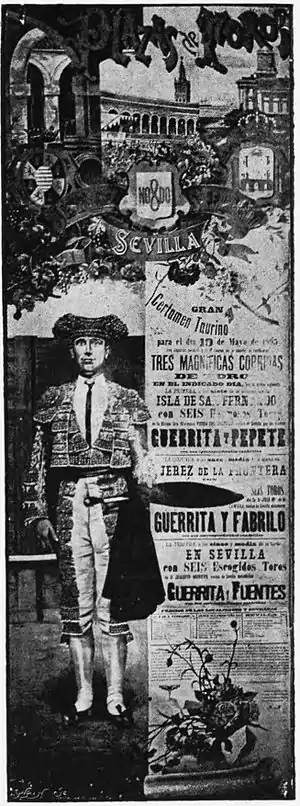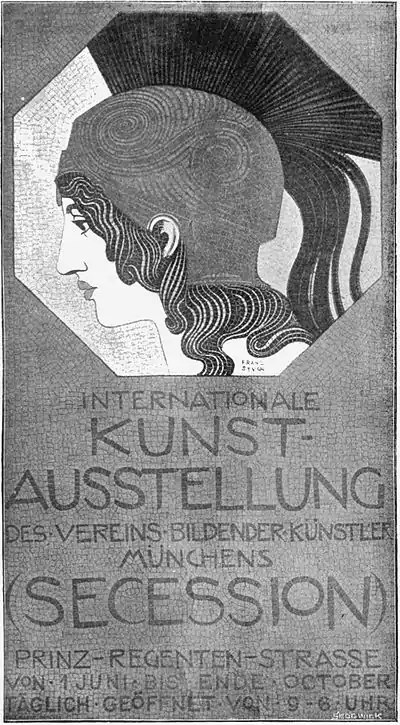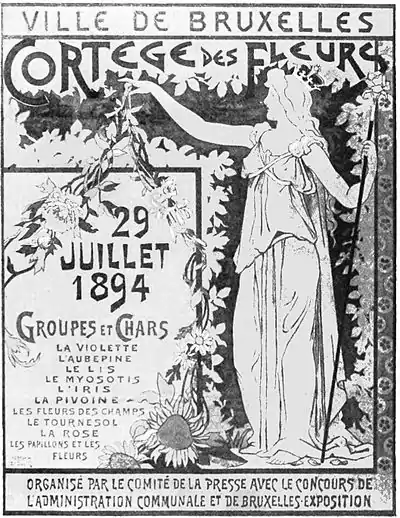| CHAPTER X. |
THE PICTORIAL POSTER IN COUNTRIES NOT ALREADY DISCUSSED.

POSTER DESIGNED TO ADVERTISE AN ENTERTAINMENT AT SEVILLE.

SPANISH POSTER FOR A FAIR.

DESIGN BY JOSEPH SATTLER.
movement; they are satisfactory in their purely decorative work, but figures in repose are apt to become 'woodeny.' In point of colour, Spain beats France; and as France is so much in advance of England, it scarcely needs a Euclid to demonstrate that English posters cannot be compared to those of Spain. The latter exhibit at times an admirable sense of distance and proportion, which serves to show that their designers learnt to draw before they began to paint." The four examples reproduced here will serve to indicate the type of Spanish poster most frequently met with. Whether Spain, in the matter of the pictorial placard, is in advance of France or not, is a question of taste. However brilliant the colour of the Spanish affiche, the design seems to me to lack boldness. Take, for example, the "Gran Feria de Cordoba, 1895;" in this case the whole thing appears to be a series of elaborate details rather than a bold and impressive design. The poster in Spain, however, is rapidly becoming of interest, dealing as it does with fascinating and essentially picturesque subjects. It is difficult to obtain exact information concerning the artists who design posters in Spain; the examples which I reproduce here, I cannot attribute to anybody with any degree of certainty.
The Teutonic temperament is in no sense akin to the Spanish, and the pictorial posters of Germany are utterly unlike those of Spain. For the most part the Germans have, in the past, been addicted to elaborate and often admirably-executed lithographs, such, for instance, as that done by Ernest Klint for the Musical and Theatrical Exhibition held at Vienna in 1892. A new movement is, it appears, making itself conspicuous just now. The younger generation of German designers seem to be as anxious to experiment in the making of posters as those of France and England. Joseph Sattler, a designer of considerable originality and great dexterity, who has studied Albrecht Dürer with great advantage to his own work, has designed a very curious little window bill to advertise "Pan." It is reproduced here, and its strange individuality, its ingenuity, will not fail to make an impression upon those who look at it closely. The lettering is devised in an extraordinary way, and Sattler may be congratulated on the results of an interesting experiment. Very different to the work of Sattler is that of Franz Stück. This represents a classical head in mosaic, and advertises an exhibition of the Munich Secessionists, a body of experimental painters and designers of rapidly-growing importance. The tendency of the illustrated poster in Austria is much the same as it is in Germany. Some admirable bills have been designed in Italy. Of its particular kind, I have seen few things better than a large and 
DESIGN BY FRANZ STÜCK.

DESIGN BY EVENEPOEL.

DESIGN BY DUYCK.

DESIGN FOR THE "LIBRE ESTHETIQUE."

DESIGN BY GAUDY.

DESIGN BY X. M.

DESIGN BY A. CRESPIN.

DESIGN BY LEON BARDENNE.